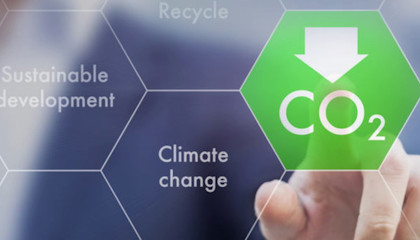A commitment to the future

By joining the United Nations backed Science Based Targets initiative, Sandvik has formally committed to cutting its CO2 emissions to net zero emissions by 2050 at the latest. This is a historic commitment that everyone who works for Sandvik can be proud of. It is also a commitment that makes good business sense.
In 2018, Sandvik had convened the first meeting of the project group to establish its 2030 Sustainability goals.
“There wasn’t this consciousness about climate that there is today,” says Mats W Lundberg, Head of Sustainability at Sandvik. “At the time, some of us weren’t so comfortable with our targets. They were seen as a bit too far-reaching. But now, our 2030 Sustainability goals are not questioned at all. Sustainability is mainstream. And our goals have been embraced by everyone.”
A big step forward
The 2030 sustainably goals were presented in May 2019. The key climate-related ones include the target to halve the CO2 impact and to create at least 90 percent material circularity. Their creation marked a big step forward in the shift towards sustainability, even though Sandvik had worked with environmental goals for many years.
“We had not had long-term goals before,” says Lundberg. “We had rolling three-year targets. But the problem with that is you don’t have long-term horizons. You can be meeting your short-term targets to reduce emissions, but it’s not enough in the long run.”
This is a historic thing for Sandvik. It is huge.
Now, just three years after the target to halve its CO2 impact by 2030 was set, a target which is currently on track, Sandvik has, by joining the Science Based Targets initiative (SBTi), committed to cutting its CO2 emissions to net zero by 2050 at the latest.
“This is a historic thing for Sandvik,” says Lundberg. “It is huge. And the fact that it has happened in such a short time span shows how quickly we have matured as a company in terms of sustainability.”
The SBTi is a partnership between CDP (previously the Carbon Disclosure Project, a charity that runs the global disclosure system for investors, companies and states to manage their environmental impacts), the United Nations Global Compact, World Resources Institute and the World Wide Fund for Nature. It seeks to mobilize the private sector to take the lead on urgent climate action. It is dedicated to limiting global warming to 1.5°C by reducing greenhouse gas emissions to net zero by 2050, in line with the 2015 Paris Agreement.
Joining SBTi is in part a way of getting our 2030 targets verified by a very credible third party.
Targets are considered ‘science-based’ if they are in line with what the latest climate science deems necessary to meet the goals of the Paris Agreement. Setting a science-based target provides a clearly defined pathway for companies to reduce greenhouse gas emissions accordingly. The targets are independently assessed and approved in line with strict criteria.
“Our targets are already science based,” says Lundberg. “We’re an engineering organization. So, for us, joining SBTi is in part a way of getting our 2030 targets verified by a very credible third party. But more importantly, it is a way of ensuring that we create a bigger longer-term target. It helps us plan for what happens after 2030.”
Makes perfect business sense
Lundberg also points out that this long-term commitment makes perfect business sense, for several reasons: “A good example is the need to build a new factory. If you know that you need to be net zero by 2050, you won’t build something that you’d need to rebuild 20 years from now, which you might if you only have the 2030 targets. Business decisions and sustainability therefore start to merge, and you start to make really long-term investments and better business decisions.”
Lundberg says that the net zero target will also reduce the future cost of energy needed for operations: “Everyone predicts that the cost of fossil fuels and electricity will go up. But if we plan for having net-zero emissions early on, we can save money. We can also make longer term contracts for the procurement of renewable energy.”
We are acting as industry leaders, not only with our products but also for sustainability.
A third-party stamp of approval also has a big business benefit, Lundberg thinks: “It adds credibility, which is great for investors or shareholders. When they ask what we are doing with climate, we can point to SBTi. All our major shareholders want us to do this. If they can say the companies that they own are part of SBTi, that adds value to their investments.”
Lundberg also believes that, as an engineering organization, Sandvik employees will be proud of the commitment to net zero emissions that the company has made. This will in turn help with employee engagement, retention and attracting new talent.
“There are so many business reasons to join SBTi, including competitiveness. We are pushing the boundaries of our peers and acting as industry leaders, not only with our products but also for sustainability. This will be a new chapter in the history of Sandvik.”
Joining the Science Based Targets Initiative
- In spring 2021, Mats W Lundberg, Head of Sustainability at Sandvik, asked his sustainability colleagues in each business area to investigate the benefits of joining the SBTi. Each business area and group function approved the idea.
- In December 2021, the Sandvik Board approved committing to net zero emissions by 2050 at the latest.
- A project group at Sandvik will now, for up to a 24 month period, work with SBTi to develop a strategy to achieve net zero emissions by 2050 at the latest.